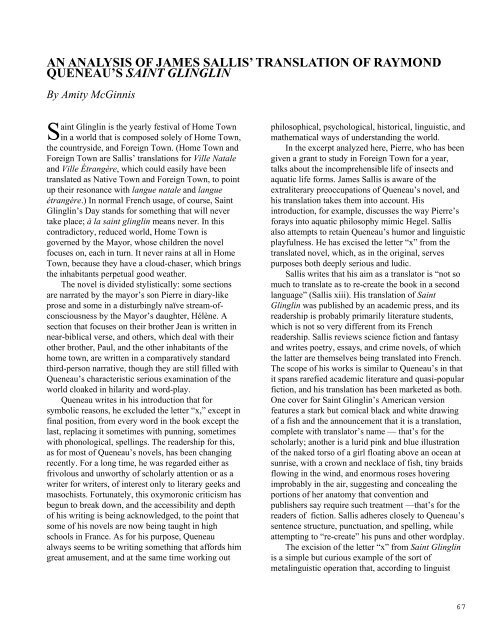their - The University of Texas at Dallas
their - The University of Texas at Dallas
their - The University of Texas at Dallas
Create successful ePaper yourself
Turn your PDF publications into a flip-book with our unique Google optimized e-Paper software.
AN ANALYSIS OF JAMES SALLIS’ TRANSLATION OF RAYMOND<br />
QUENEAU’S SAINT GLINGLIN<br />
By Amity McGinnis<br />
S<br />
aint Glinglin is the yearly festival <strong>of</strong> Home Town<br />
in a world th<strong>at</strong> is composed solely <strong>of</strong> Home Town,<br />
the countryside, and Foreign Town. (Home Town and<br />
Foreign Town are Sallis’ transl<strong>at</strong>ions for Ville N<strong>at</strong>ale<br />
and Ville Étrangère, which could easily have been<br />
transl<strong>at</strong>ed as N<strong>at</strong>ive Town and Foreign Town, to point<br />
up <strong>their</strong> resonance with langue n<strong>at</strong>ale and langue<br />
étrangère.) In normal French usage, <strong>of</strong> course, Saint<br />
Glinglin’s Day stands for something th<strong>at</strong> will never<br />
take place; à la saint glinglin means never. In this<br />
contradictory, reduced world, Home Town is<br />
governed by the Mayor, whose children the novel<br />
focuses on, each in turn. It never rains <strong>at</strong> all in Home<br />
Town, because they have a cloud-chaser, which brings<br />
the inhabitants perpetual good we<strong>at</strong>her.<br />
<strong>The</strong> novel is divided stylistically: some sections<br />
are narr<strong>at</strong>ed by the mayor’s son Pierre in diary-like<br />
prose and some in a disturbingly naïve stream-<strong>of</strong>consciousness<br />
by the Mayor’s daughter, Hélène. A<br />
section th<strong>at</strong> focuses on <strong>their</strong> brother Jean is written in<br />
near-biblical verse, and others, which deal with <strong>their</strong><br />
other brother, Paul, and the other inhabitants <strong>of</strong> the<br />
home town, are written in a compar<strong>at</strong>ively standard<br />
third-person narr<strong>at</strong>ive, though they are still filled with<br />
Queneau’s characteristic serious examin<strong>at</strong>ion <strong>of</strong> the<br />
world cloaked in hilarity and word-play.<br />
Queneau writes in his introduction th<strong>at</strong> for<br />
symbolic reasons, he excluded the letter “x,” except in<br />
final position, from every word in the book except the<br />
last, replacing it sometimes with punning, sometimes<br />
with phonological, spellings. <strong>The</strong> readership for this,<br />
as for most <strong>of</strong> Queneau’s novels, has been changing<br />
recently. For a long time, he was regarded either as<br />
frivolous and unworthy <strong>of</strong> scholarly <strong>at</strong>tention or as a<br />
writer for writers, <strong>of</strong> interest only to literary geeks and<br />
masochists. Fortun<strong>at</strong>ely, this oxymoronic criticism has<br />
begun to break down, and the accessibility and depth<br />
<strong>of</strong> his writing is being acknowledged, to the point th<strong>at</strong><br />
some <strong>of</strong> his novels are now being taught in high<br />
schools in France. As for his purpose, Queneau<br />
always seems to be writing something th<strong>at</strong> affords him<br />
gre<strong>at</strong> amusement, and <strong>at</strong> the same time working out<br />
philosophical, psychological, historical, linguistic, and<br />
m<strong>at</strong>hem<strong>at</strong>ical ways <strong>of</strong> understanding the world.<br />
In the excerpt analyzed here, Pierre, who has been<br />
given a grant to study in Foreign Town for a year,<br />
talks about the incomprehensible life <strong>of</strong> insects and<br />
aqu<strong>at</strong>ic life forms. James Sallis is aware <strong>of</strong> the<br />
extraliterary preoccup<strong>at</strong>ions <strong>of</strong> Queneau’s novel, and<br />
his transl<strong>at</strong>ion takes them into account. His<br />
introduction, for example, discusses the way Pierre’s<br />
forays into aqu<strong>at</strong>ic philosophy mimic Hegel. Sallis<br />
also <strong>at</strong>tempts to retain Queneau’s humor and linguistic<br />
playfulness. He has excised the letter “x” from the<br />
transl<strong>at</strong>ed novel, which, as in the original, serves<br />
purposes both deeply serious and ludic.<br />
Sallis writes th<strong>at</strong> his aim as a transl<strong>at</strong>or is “not so<br />
much to transl<strong>at</strong>e as to re-cre<strong>at</strong>e the book in a second<br />
language” (Sallis xiii). His transl<strong>at</strong>ion <strong>of</strong> Saint<br />
Glinglin was published by an academic press, and its<br />
readership is probably primarily liter<strong>at</strong>ure students,<br />
which is not so very different from its French<br />
readership. Sallis reviews science fiction and fantasy<br />
and writes poetry, essays, and crime novels, <strong>of</strong> which<br />
the l<strong>at</strong>ter are themselves being transl<strong>at</strong>ed into French.<br />
<strong>The</strong> scope <strong>of</strong> his works is similar to Queneau’s in th<strong>at</strong><br />
it spans rarefied academic liter<strong>at</strong>ure and quasi-popular<br />
fiction, and his transl<strong>at</strong>ion has been marketed as both.<br />
One cover for Saint Glinglin’s American version<br />
fe<strong>at</strong>ures a stark but comical black and white drawing<br />
<strong>of</strong> a fish and the announcement th<strong>at</strong> it is a transl<strong>at</strong>ion,<br />
complete with transl<strong>at</strong>or’s name — th<strong>at</strong>’s for the<br />
scholarly; another is a lurid pink and blue illustr<strong>at</strong>ion<br />
<strong>of</strong> the naked torso <strong>of</strong> a girl flo<strong>at</strong>ing above an ocean <strong>at</strong><br />
sunrise, with a crown and necklace <strong>of</strong> fish, tiny braids<br />
flowing in the wind, and enormous roses hovering<br />
improbably in the air, suggesting and concealing the<br />
portions <strong>of</strong> her an<strong>at</strong>omy th<strong>at</strong> convention and<br />
publishers say require such tre<strong>at</strong>ment —th<strong>at</strong>’s for the<br />
readers <strong>of</strong> fiction. Sallis adheres closely to Queneau’s<br />
sentence structure, punctu<strong>at</strong>ion, and spelling, while<br />
<strong>at</strong>tempting to “re-cre<strong>at</strong>e” his puns and other wordplay.<br />
<strong>The</strong> excision <strong>of</strong> the letter “x” from Saint Glinglin<br />
is a simple but curious example <strong>of</strong> the sort <strong>of</strong><br />
metalinguistic oper<strong>at</strong>ion th<strong>at</strong>, according to linguist<br />
67

















